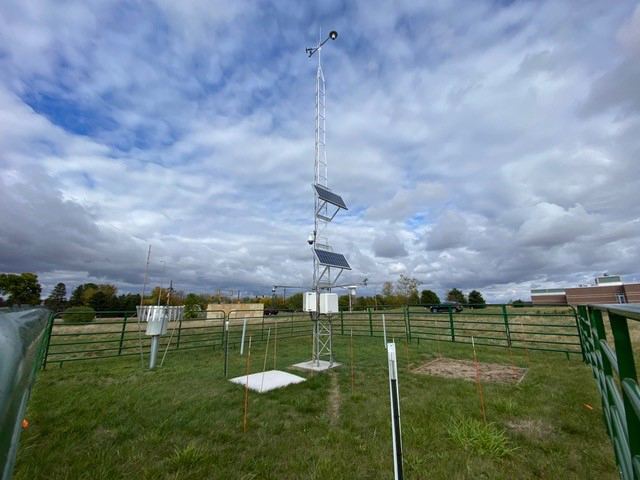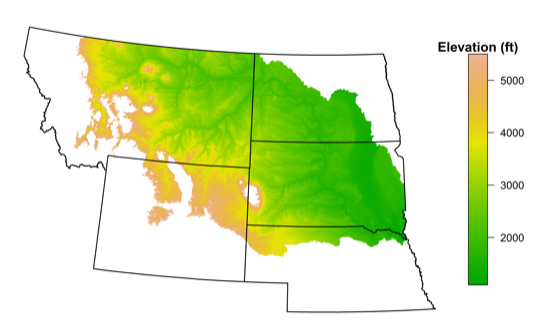UM Climate Office Awarded $21 Million to Bolster Montana Weather Stations, Snowpack Data

This is an example of the 500 weather stations to be retrofitted or installed in the Upper Missouri River Basin. (Credit: Genna Langum, South Dakota Mesonet.)
MISSOULA – The Army Corps of Engineers has awarded a $21 million contract to the Montana Climate Office at the University of Montana to install weather stations for monitoring snowpack and soil moisture in the Upper Missouri River Basin.
Under the contract, UM researchers will install these new weather stations in central and eastern Montana – east of the Rocky Mountain front in the Upper Missouri River basin – an area notoriously underrepresented and undermeasured when it comes to climate data.
“If you look at a map of snowpack, we all think of the mountains in western Montana. There isn’t a lot of snow in our plains. It’s not that it doesn’t occur, it’s that we don’t have data. That’s a problem,” said Kelsey Jencso, an associate professor of hydrology in the W.A. Franke College of Forestry and Conservation and the Montana state climatologist. “That area is sparsely populated, but what happens there has a big impact hydrologically downstream.”
The new stations measure weather variables, including relative humidity, temperature, solar radiation, windspeed, wind direction, snowpack height, and snow and rainfall depths. Below ground, they also measure soil water content at multiple depths, soil temperature and soil water electrical conductivity as a proxy of water quality.
Measurements are collected every five minutes and are shared with key federal agencies and can be viewed online by the public. That data will be used by federal agencies to help with flood control and can also be used by state agencies to help improve drought monitoring, agricultural production and fire preparedness.
Montana forms the headwaters of a land area that drains across almost two-thirds of the contiguous United States. Montana weather and climate conditions, from drought to flooding to fire, impact not only Montanans but also infrastructure, lives and economies downstream.
This new project stems from the largescale flooding in the Missouri River Basin in 2011 and again in 2019, which caused billions of dollars in damage downstream.
The contract is part of a larger collaboration with climate offices in Wyoming, South Dakota, North Dakota and Nebraska that will cover about a quarter million square miles with over 500 weather stations – a station about every 25 miles.

The colored portions of this map indicate the area where weather stations, with advanced snowpack and soil moisture monitoring capabilities, will be deployed. (Credit: Ruben Behnke, South Dakota Mesonet)
Soil moisture and snowpack are key drivers of drought and flooding in the Upper Missouri River Basin, but they are difficult to measure. The new stations were designed specifically to provide data needed by snow modelers and river forecasters to improve products that inform reservoir management. New data and more knowledge about snowpack and soil moisture in the region will allow the National Oceanic and Atmospheric Administration’s flood forecast centers and the Corps’ reservoir management team to better predict floods and control reservoirs to minimize impacts.
The project also affects Montana directly. While the data is intended for flood management, it can be used locally to better assess drought conditions, to plan for evolving fire conditions and to improve precision agriculture by helping producers predict the best times to plant and harvest by showing water availability for plants.
“That’s part of our mission at the climate office,” Jensco said. “We want to use this federal grant to support flood forecasting, but it opens up a lot of other uses for Montana.”
“I’m excited not just about the fact that there will be more stations, but that we will have really high-quality data streams coming in that we can utilize for different projects,” said Zachary Hoylman, the assistant state climatologist in the Montana Climate Office and a UM alumnus. “It’s not just about the data, it’s about the opportunities that the data represents.”
The project is connected to the Montana Mesonet Project, which was started in 2016 to build a network of weather stations in Montana. Conversations about the Corps’ project began in 2012, Jencso said, and the Montana Mesonet started off small, with just six stations, and grew quickly as a proof of concept and a foundation for this larger project. There are currently 80 stations in the Montana Mesonet.
The Montana Climate Office will begin work on the new phase this spring by installing 10 new weather stations, with 20 more to follow by the end of 2021. After that, they will install 50 stations a year until the project is complete. The team will work with federal, state and private partners like farmers and ranchers and with collaborators at Montana State University to identify new sites.
Many of Montana’s existing weather stations also will get an upgrade as part of this new contract. Additionally, the new stations are larger and capable of measuring additional variables like snowpack.
This project will create up to 10 seasonal paid internships for UM undergraduate students as summer hydrological technicians. Jencso said the interns will get plenty of on-the-job training, everything from digging the holes to installing the sensors to analyzing data.
Students will receive applied training in climate, meteorology, hydrology and soil science. They’ll also gain hands-on experience with environmental sensors and programming that is important for entry into careers as water resources professionals. Interns will work in the Climate Office’s soils laboratory to develop models that allow research to use the real-time data from the stations to predict variables helpful for agricultural producers like plant-available water and fertilizer application rates.
Other project collaborators include Kevin Hyde, the Montana Mesonet manager in the Montana Climate Office; Kyle Bocinsky, research associate in the Montana Climate Office; Bruce Maxwell, professor of weed and invasive plant ecology at Montana State University; the Montana Department of Nature Resources and Conservation; and U.S. Natural Resources and Conservation Service.
Members of the climate office team say they’re also excited to work with new partners and connect with parts of Montana they never have before.
“It builds a foundation as a state to adapt to year-to-year variability in weather and extreme weather events,” Jencso said. “But it also provides a means for us to characterize how our climatic conditions change over time. It’s an important project and a key stepping stone to making better decisions across the state. Those decisions impact our economy and productivity as a state. During good times, when we have good growing conditions, we can grow more crops. During bad times, we can prepare. It allows us to better manage our landscape.”
###
Contact: Kelsey Jencso, associate professor of hydrology, UM W.A. Franke College of Forestry & Conservation, 406-243-6793, kelsey.jencso@umontana.edu.